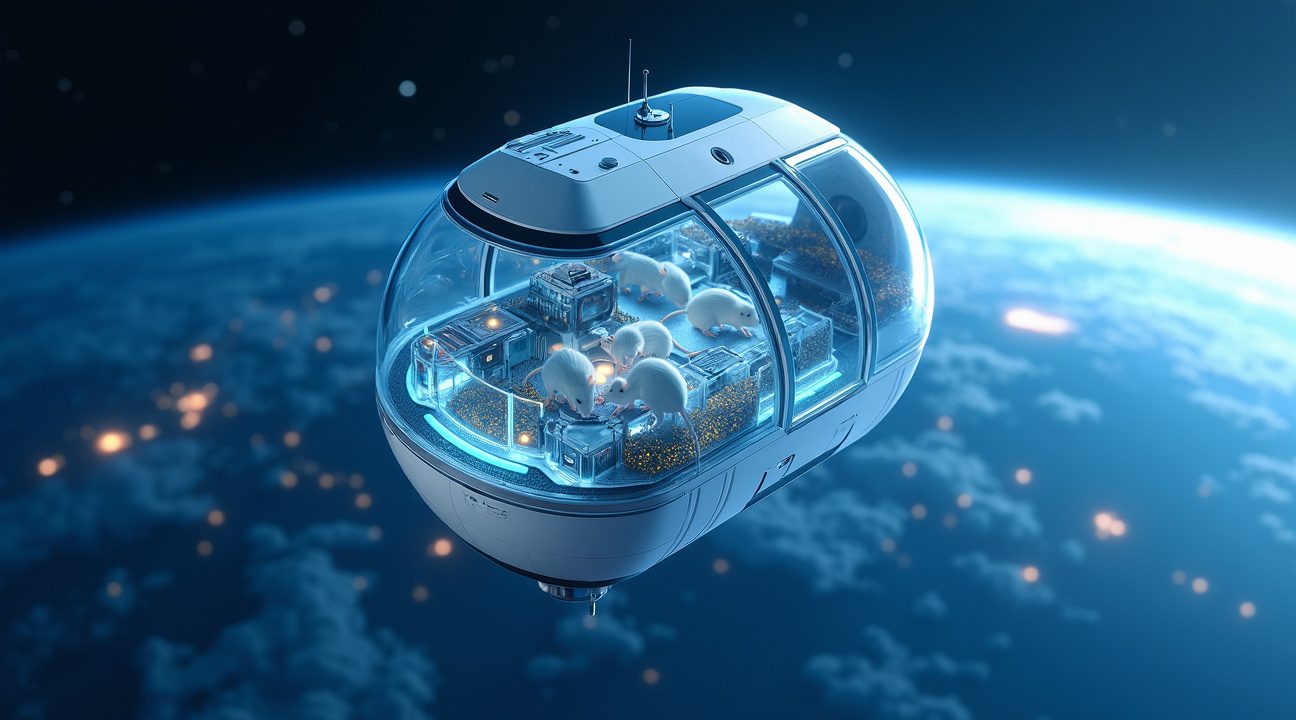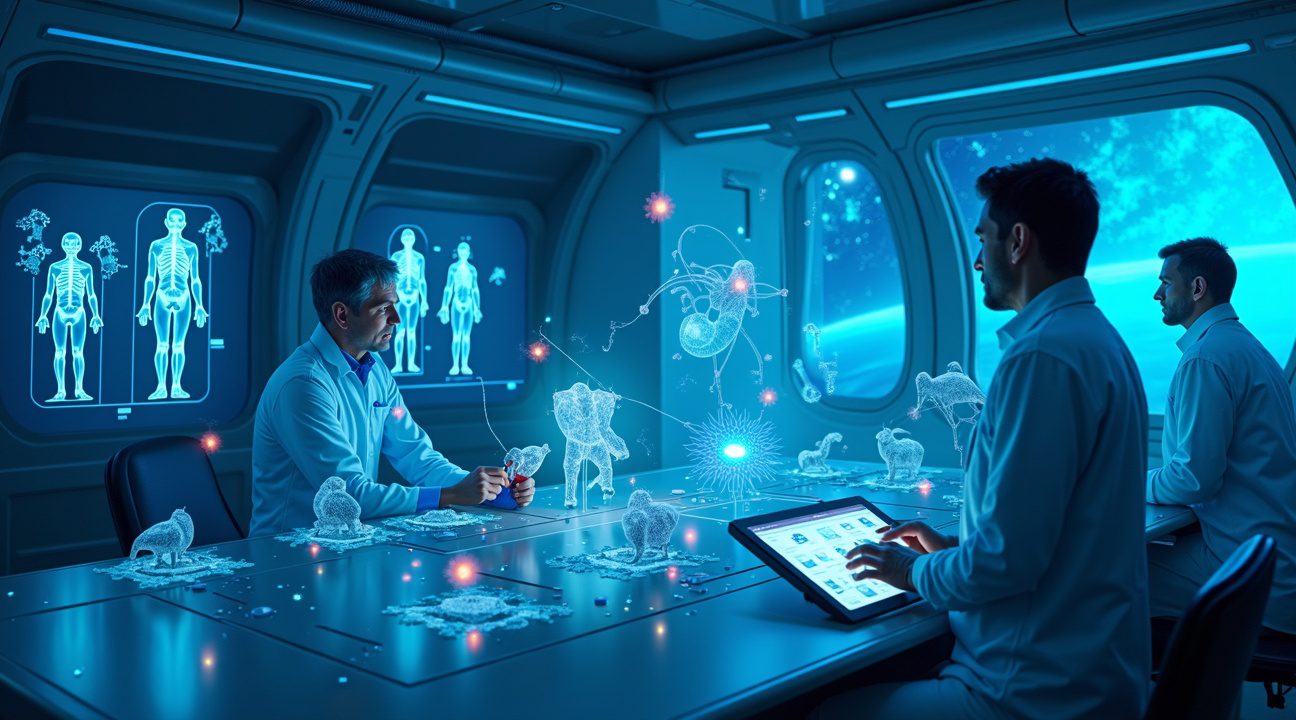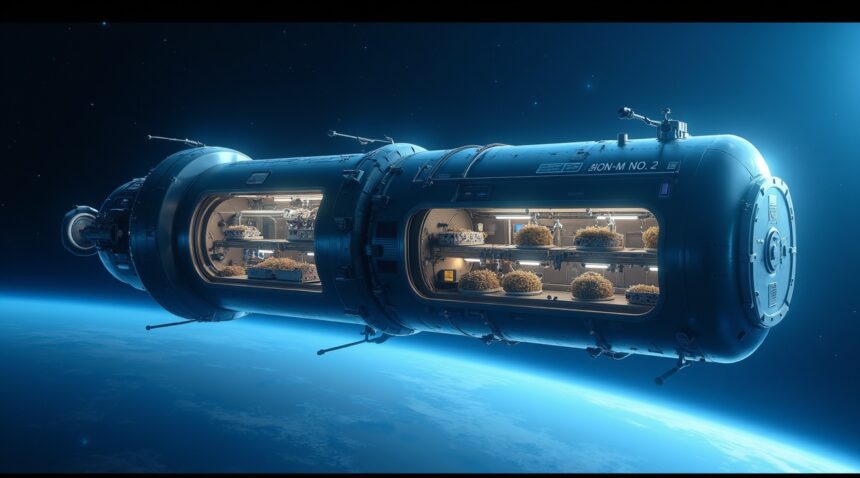Russia’s August 20 launch of the Bion-M No. 2 biosatellite will carry 75 mice and 1,000 fruit flies on a month-long orbital mission to study how microgravity affects biological systems.
Key Takeaways
- Russia will launch 75 mice and 1,000 fruit flies on August 20, 2025, aboard the Bion-M No. 2 biosatellite for a month-long orbital research mission
- The mission combines mammalian and invertebrate models to study microgravity effects on bone density, muscle mass, cardiovascular function, and genetic expression
- Research findings will directly inform safety protocols and medical countermeasures for future human missions to Mars and extended lunar stays
- The study’s insights extend beyond space exploration to terrestrial medicine, potentially advancing treatments for osteoporosis, muscle wasting, and age-related conditions
- This mission continues Russia’s six-decade legacy of animal space research while embracing modern scientific methodologies that emphasize larger sample sizes for statistical significance
Scientific Significance of the Bion-M No. 2 Mission
Scientists recognize this mission as a pivotal moment in space biology research. The substantial number of test subjects allows researchers to draw more reliable conclusions about microgravity’s effects on living systems. Previous space biology missions often carried smaller animal populations, limiting their statistical power and scientific validity.
Diversified Biological Models
The mission’s dual-species approach provides complementary insights into biological responses to spaceflight. Mice serve as excellent mammalian models, sharing many physiological similarities with humans. Their responses to microgravity help scientists predict how human astronauts might adapt to extended space missions. Fruit flies, meanwhile, offer unique advantages as research subjects due to their well-understood genetics and rapid life cycles.
Focus Areas for Research
Research teams expect to gather unprecedented data on bone loss, muscle atrophy, and cardiovascular changes during the month-long mission. These physiological adaptations pose serious challenges for long-duration spaceflight and could significantly impact crew health during missions to Mars or permanent lunar settlements. Understanding these changes enables researchers to develop more effective countermeasures and protective protocols.
Genetic Expression in Space
The mission also focuses on genetic expression changes in microgravity environments. Scientists will examine how space conditions alter cellular function at the molecular level, potentially revealing new targets for therapeutic intervention. This genetic research could lead to breakthrough treatments for conditions that affect millions of people on Earth.
Russia’s Legacy and Future Outlook
Russia’s space agency selected these particular species based on decades of research experience and proven scientific protocols. The country’s extensive history with animal space missions provides valuable baseline data for comparison. Modern technological advances now allow for more sophisticated monitoring and data collection than previous missions could achieve.
Medical researchers anticipate that findings from this mission will accelerate development of treatments for age-related diseases and mobility disorders. The rapid bone loss and muscle wasting observed in microgravity closely mirror conditions seen in elderly patients and individuals with various medical conditions. Effective space-based countermeasures could translate into powerful therapeutic approaches for terrestrial medicine.
The Bion-M No. 2 mission represents a strategic investment in humanity’s spacefaring future. As space agencies plan ambitious missions to Mars and establish permanent lunar bases, understanding biological responses to extended microgravity exposure becomes increasingly critical. The data collected during this mission will directly inform mission planning, crew health protocols, and life support system design for future deep space exploration.
Russia’s “Miniature Mouse Hotel” Blasts Off August 20 with 75 Mice and 1,000 Fruit Flies
Russia prepares to launch an extraordinary biological research mission on August 20, 2025, sending the Bion-M No. 2 biosatellite into Earth orbit with a unique cargo of 75 mice and 1,000 fruit flies. This month-long mission has earned the playful nickname of launching a “miniature mouse hotel” into space, reflecting the specialized habitat designed to keep these research subjects alive during their orbital journey.
Advanced Biosatellite Technology for Biological Research
The Bion-M No. 2 represents a significant leap forward in Russia’s biological space research program. This mission is particularly fascinating because it combines cutting-edge technology with fundamental biological research questions that affect both animal and human spaceflight. The biosatellite functions as a sophisticated laboratory, equipped with life support systems, monitoring equipment, and specialized compartments designed to maintain optimal conditions for its living passengers throughout the month-long orbital mission.
The choice of test subjects isn’t random — mice and fruit flies serve as excellent model organisms for understanding how microgravity affects biological systems. Researchers can observe how these creatures adapt to weightlessness, providing valuable insights into:
- Bone density loss
- Muscle atrophy
- Cardiovascular changes
- Neurological adaptations during extended periods in space
Implications for Future Space Exploration
This mission builds upon decades of biological research conducted in space environments. The data collected from the 75 mice and 1,000 fruit flies will contribute to our understanding of how living organisms respond to prolonged exposure to microgravity conditions. Such research is essential for planning longer human missions, including potential trips to Mars and extended stays on lunar bases.
The timing of the August 20, 2025 launch aligns with Russia’s renewed focus on space research capabilities. The results from the Bion-M No. 2 mission are expected to inform future:
- Spacecraft design
- Life support systems
- Medical protocols for astronauts
The “miniature mouse hotel” concept demonstrates how space agencies continue to innovate in creating controlled environments for biological research beyond Earth’s atmosphere. Russia’s commitment to this type of research highlights the importance of understanding biological responses to space environments before committing to longer human missions. The month-long duration provides sufficient time to observe meaningful physiological changes while remaining practical for current technology limitations.

Spaceflight’s Impact on Living Organisms Through Biological Research
Russia’s upcoming mission represents a significant step forward in understanding how microgravity affects biological systems. The carefully planned experiment will examine both mammalian and invertebrate responses to spaceflight conditions, providing crucial data about the fundamental changes that occur when living organisms leave Earth’s gravitational field.
Previous missions conducted by Russian and American space agencies have already revealed concerning patterns in how microgravity influences animal physiology. These studies consistently show that muscle, bone, and tendon mass undergo significant changes during spaceflight exposure. The data collected from these earlier experiments has established a foundation for understanding the biological challenges that accompany space travel.
Medical Applications Beyond Space Exploration
The research extends far beyond astronaut health concerns, offering potential breakthroughs for terrestrial medical applications. Scientists anticipate that insights from this mission will enhance understanding of muscle loss conditions that affect millions of people on Earth. The findings could prove particularly valuable in several key areas:
- Geriatric medicine, where age-related muscle deterioration affects quality of life
- Treatment protocols for individuals with chronic illnesses that cause muscle wasting
- Rehabilitation strategies for people experiencing long-term immobilization due to injury or illness
- Development of countermeasures for bedridden patients in hospitals and care facilities
This biological research serves as a unique window into how gravity influences fundamental cellular processes. The microgravity environment essentially removes one of the most consistent forces that life on Earth has evolved to handle, creating an ideal laboratory for studying gravitational biology.
Understanding astronaut health risks becomes increasingly critical as space exploration advances and missions grow longer. The data from these 75 mice and 1000 fruit flies will contribute to developing protective measures for future space travelers, potentially informing everything from exercise protocols to pharmaceutical interventions.
The selection of both mammals and invertebrates creates comprehensive biomedical models that allow researchers to study spaceflight effects across different biological systems. Mice share many physiological similarities with humans, making them excellent models for understanding how microgravity might affect astronauts. Fruit flies, despite their simplicity, offer insights into basic cellular and genetic responses to spaceflight conditions.
Each organism responds differently to the absence of gravity, and these variations provide researchers with multiple perspectives on the same fundamental question: how does life adapt when one of its most basic environmental constants disappears? The August 20 mission promises to add valuable data to this growing field of space biology research.

Why 75 Mice and 1,000 Fruit Flies Make Perfect Space Travelers
I find it fascinating how Russia’s upcoming August 20 mission strategically combines two distinct yet complementary animal models to unlock the mysteries of spaceflight’s biological impact. The Bion-M No. 2 biosatellite will carry 75 mice and 1,000 fruit flies into orbit, each species chosen for specific scientific advantages that maximize research potential.
Mice: Earth’s Best Human Stand-ins
The 75 mice aboard this mission serve as primary mammalian models because their physiology closely mirrors human biology. These small mammals provide invaluable insights into how organs, tissues, and bodily systems respond to prolonged microgravity exposure. Scientists can monitor changes in bone density, muscle mass, cardiovascular function, and neural activity — all critical factors for understanding how humans might fare during extended space missions.
Mice offer several practical advantages for space research:
- Manageable size within the biosatellite’s controlled environment
- Relatively short lifespans that allow researchers to observe complete biological cycles during missions
- Well-documented genetics and physiology for baseline comparison against space-induced changes
Fruit Flies: Genetic Research Powerhouses
The mission’s 1,000 fruit flies (Drosophila) represent a different but equally valuable research approach. I appreciate how these tiny creatures compensate for what they lack in size with their remarkable genetic research capabilities. Several factors make fruit flies ideal for space-based genetic studies:
- Thoroughly studied genetics that provide scientists with comprehensive baseline data
- Fast generational turnover allowing researchers to observe multiple life cycles during the mission
- Simple care requirements that minimize mission complexity and resource demands
- High reproduction rates enabling studies of genetic inheritance across generations
- Established protocols for genetic analysis that streamline post-mission research
Scientists will examine how microgravity affects genetic expression, developmental processes, and reproductive success in these insects. The fruit flies’ rapid breeding cycles could reveal multi-generational effects that might take years to observe in larger mammals.
The Bion-M No. 2 biosatellite creates a sophisticated controlled environment where researchers can monitor both species’ health, activity levels, and biological changes throughout the orbital mission. This careful observation will track survival rates, reproductive success, and both physical and genetic modifications that occur during spaceflight.
Russia’s choice to combine these animal models demonstrates smart mission planning. While mice provide mammalian insights relevant to human space exploration, fruit flies offer rapid genetic analysis capabilities that could reveal fundamental biological responses to space environments. This dual approach maximizes scientific return from a single mission, addressing questions about microgravity health impacts across different biological scales.
The mission builds upon decades of space biology research, continuing investigations that began with early space exploration efforts. Understanding how living organisms adapt to space conditions remains crucial as humans prepare for longer missions to destinations like Mars.
Data from this mission will contribute to ongoing research about genetic research applications in space medicine and help develop countermeasures for the biological challenges astronauts face. The combination of mammalian physiology studies through mice and genetic research through fruit flies creates a comprehensive approach to understanding life’s response to the space environment.
Both species will undergo careful pre-flight health assessments and post-mission analysis to document changes that occurred during their orbital journey. This research continues humanity’s quest to understand how life adapts beyond Earth’s protective atmosphere, informing future missions that will carry humans deeper into the solar system.

From Soviet Space Dogs to Modern Biosatellites: Russia’s Animal Space Legacy
Russia’s upcoming launch of 75 mice and 1000 fruit flies represents the latest chapter in a storied tradition that began over six decades ago. The Soviet Union pioneered animal spaceflight research, establishing protocols and methodologies that continue to shape biological research beyond Earth’s atmosphere today.
Soviet scientists first sent dogs into space during the 1950s, with Laika becoming the most famous canine cosmonaut in 1957. These early missions proved that living organisms could survive the harsh conditions of space travel, paving the way for human spaceflight. Following the success with dogs, researchers expanded their biological cargo to include monkeys, rabbits, frogs, and various smaller creatures, each selected to answer specific questions about how life adapts to microgravity.
Geckos joined this distinguished roster of space travelers during the Foton-M4 mission, specifically chosen to study reproductive processes in microgravity. Scientists hoped these small reptiles would provide insights into how weightlessness affects mating behaviors and egg development. Unfortunately, communication failures with the spacecraft led to the geckos’ demise, highlighting both the potential rewards and inherent risks of space-based biological research.
Evolution of Russian Biosatellite Programs
The current Bion-M No. 2 mission marks a significant departure from earlier “Noah’s Ark”-style experiments that focused on sending diverse species collections into orbit. Modern Russian biosatellites now emphasize larger sample sizes and target more complex biological research questions. This shift reflects advances in space technology and a deeper understanding of what researchers need to study effectively.
Earlier missions often included small numbers of various animals, which limited statistical analysis and made it difficult to draw definitive conclusions about spaceflight effects. The decision to launch 75 mice and 1000 fruit flies demonstrates Russia’s commitment to generating statistically significant data that can advance our understanding of space biology.
These larger sample sizes enable researchers to study individual variations in response to microgravity, something impossible with smaller groups. Scientists can now examine how different genetic backgrounds, ages, and physiological conditions influence adaptation to space environments. This approach aligns with modern scientific standards that demand reproducible results based on adequate sample populations.
Russian space biology programs have consistently contributed valuable data about:
- Bone density loss
- Muscle atrophy
- Cardiovascular changes
- Neurological adaptations
These effects occur during extended spaceflight and the knowledge gained from these animal studies directly informs human space mission planning and helps develop countermeasures to protect astronauts during long-duration flights.
The transition from diverse species collections to focused, large-scale studies also reflects practical considerations. Managing 75 mice requires different life support systems than caring for a mixed menagerie of creatures with varying environmental needs. This specialized approach allows for more precise experimental controls and better data quality.
Russia’s biosatellite history demonstrates how space exploration programs evolve from proof-of-concept missions to sophisticated research platforms. Each successful animal flight has built upon previous discoveries, creating an accumulated knowledge base that benefits international space programs.
The upcoming August 20 launch continues this legacy while embracing modern research methodologies. By combining traditional Russian expertise in space biology with contemporary scientific approaches, the Bion-M No. 2 mission positions itself to generate meaningful insights about how living systems respond to the space environment. This research proves essential as humans prepare for longer missions to the Moon, Mars, and beyond, where understanding biological adaptation to space conditions becomes increasingly critical for mission success and crew safety.
Paving the Way for Human Space Exploration and Medical Breakthroughs
The data collected from the Bion-M No. 2 mission represents far more than an academic exercise. I find this research particularly significant because it directly addresses the critical health challenges that crews will face during extended missions to Mars and beyond. The biological responses observed in these test subjects will inform safety protocols and medical countermeasures essential for protecting astronauts during months or years away from Earth.
Space agencies worldwide recognize that understanding microgravity effects on biology stands as one of the primary obstacles to successful interplanetary travel. The mission’s comprehensive data collection will enable researchers to develop targeted interventions for:
- Bone density loss
- Muscle atrophy
- Cardiovascular deconditioning
These findings will prove invaluable for designing exercise regimens, pharmaceutical treatments, and nutritional supplements specifically calibrated for space environments.
Advancing Earth-Based Medical Research
The applications of this research extend well beyond space exploration into terrestrial healthcare. The controlled microgravity environment provides researchers with unique insights into aging processes and the physiological changes associated with prolonged immobility. These conditions mirror many aspects of age-related decline and bedridden patient care, offering potential breakthroughs in treating:
- Osteoporosis
- Sarcopenia
- Circulatory disorders
Medical professionals studying space health risks often discover unexpected connections to Earth-based conditions. The accelerated aging effects observed in microgravity serve as a compressed timeline for understanding how various biological systems deteriorate over time. This research could lead to innovative treatments for elderly patients and individuals with mobility limitations.
Future space exploration missions will rely heavily on the protocols developed from this biological data. The mission supports ongoing efforts to establish permanent research stations on the Moon and eventual human settlements on Mars. Understanding how living organisms adapt to extended periods in space environments will inform:
- Habitat design
- Life support systems
- Emergency medical procedures
The research also contributes to expanding our knowledge of fundamental biological processes under altered gravitational conditions. These insights could revolutionize our approach to tissue engineering, regenerative medicine, and cellular biology research. The findings will help scientists develop more effective treatments for conditions where gravity plays a role in normal physiological function.
Human spaceflight programs across multiple nations will benefit from the comprehensive biological dataset generated by this mission. The research establishes crucial baseline measurements for planning crew rotations, determining mission duration limits, and developing specialized training programs for astronauts embarking on deep space missions.

Sources:
Space.com, “Russia to launch 75 mice, 1,000 fruit flies on Aug. 20 to study spaceflight effects”
Leonard David, “Russia Readies Biosatellite – a ‘Noah’s Ark’ of Specimens”
Wikipedia, “Animals in space”


